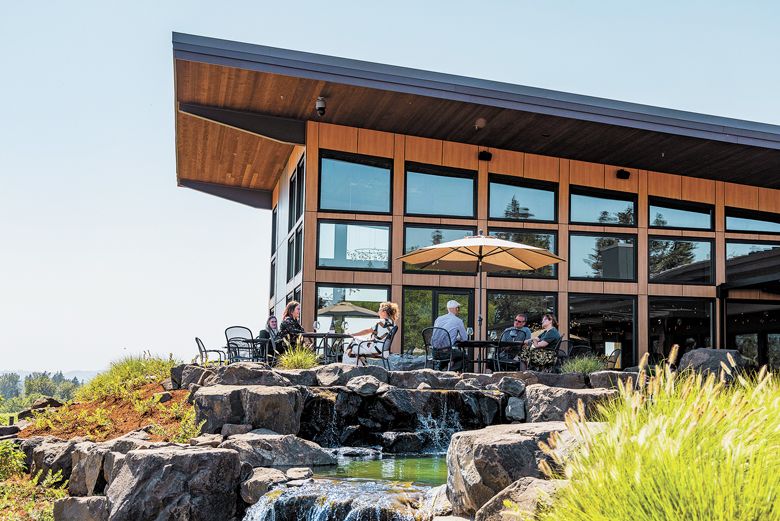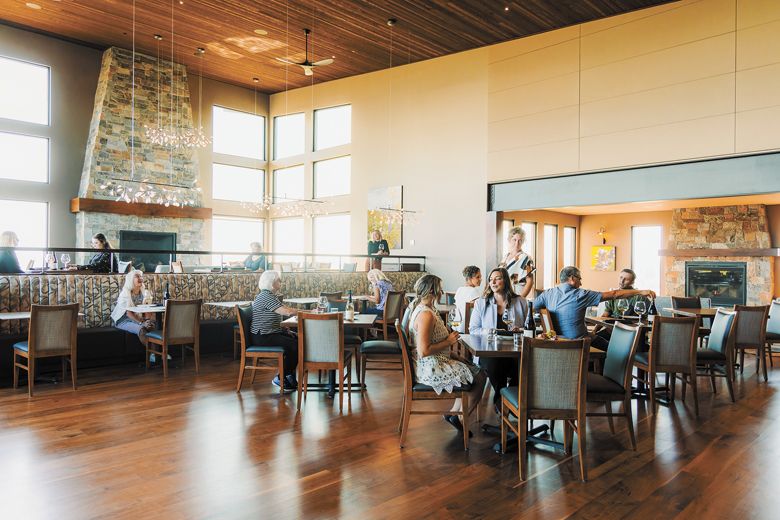Sparkling House on a Hilltop
Willamette Valley Vineyard’s Domaine Willamette Opens


By Annelise Kelly
Domaine Willamette, a new winery dedicated exclusively to crafting méthode traditionnelle sparkling wine, recently opened after five years of construction. On Highway 99W, halfway between Dundee and Dayton, visitors will discover inviting gardens, farm-to-table dining, tours and tastings.
This passion project of Jim and Jan Bernau of Willamette Valley Vineyards is an enterprise based on sustainability, community and collaboration. Landscaping and décor herald the winery’s commitment to biodynamic farming practices, with weighty granite sculptures such as a giant cow horn on display by the front entrance.
A Robust Future for Willamette Valley Sparkling Wine
Conditions in the Willamette Valley favor the production of sparkling wine, and founder Jim Bernau is confident local producers can produce wines rivaling those of Champagne.
“The world’s demand for high-quality sparkling wine has exceeded what the Champagne region can actually grow and make. The world keeps getting more wine lovers each year,” says Bernau. “We’ve already seen, in our lifetimes, the North Willamette Valley take its place among the finest wine-growing regions in the world for Pinot Noir. And I believe that we’ll see the same thing happen with méthode traditionnelle sparkling wine in our lifetimes.”
He explains that “with thin-skinned grape varieties like Pinot Noir, in particular, and also Chardonnay and Pinot Meunier, you get more aroma and flavor in the North Willamette from these varieties at lower levels of maturity.” For example, Pinot Noir grapes are harvested for red wine when the sugar content approximates 23.5-24.5 Brix, while it’s harvested for méthode traditionnelle sparkling wine about 18.5 Brix. “It’s almost like the North Willamette is just made for this because at 18.5 Brix it hasn’t started raining yet,” emphasizes Bernau.
Another factor in Oregon’s advantage is that veraison, the onset of ripening, occurs during August, our driest month. However, in grape-growing regions such as Champagne, Burgundy and Chablis, August is the wettest time of the year. As the grape clusters mature and fill out during France’s wet summers, a hospitable environment for botrytis fungus develops.
“Growers understand that month is critical for not only developing color and flavor in the fruit, but also avoiding disease,” says Bernau. “Oregon is famous for growing sustainably. We can grow in a very low-impact way, experiencing far fewer problems with powdery mildew and botrytis than our French colleagues.”
The Van Duzer winds also add to a lower incidence of disease. These cool marine breezes provide natural air conditioning, “allowing the grapes to retain more acidity. The other big advantage? It dries the fruit out. As a consequence, we have much lower levels of disease in our grapes, which means we don’t have to apply a lot of sulfur or other remedies.”
A Story of Stewardship
Bernau explains the distinction of the mutually supportive culture of Oregon winemakers. His experience while traveling is that “Oregon has a strong reputation of working together. We help each other, support each other, and protect our neighbors. We guard the customer, and protect other living creatures,” says Bernau.
Willamette Valley Vineyards has been an early pioneer in Low Input Viticulture and Enology, also known as LIVE, and Salmon-Safe certification. Domaine Willamette takes it up a notch by practicing biodynamic farming, a holistic, ethical and regenerative agricultural approach. The grounds and interior are designed to reflect this ethos. Extensive gardens feature white granite sculptures, carved in Vancouver, Washington, depicting flowers such as chamomile and yarrow– used in biodynamic preparations. Rain collected from the rooftop is used for watering.
One of Jan Bernau’s many contributions to the project has been sourcing “all this commissioned art from Oregon– it’s all intended to tell a story about sustainable and biodynamic farming,” says Jim Bernau. The Starry Sky presentation room, where guests can watch a short video, evokes the night sky and honors the celestial influences highly regarded by biodynamic farmers.
“We strove to create a winery experience for wine enthusiasts traveling from all over the world to learn about Oregon and the Willamette Valley. We built this really intriguing, inviting experience that offers an added educational component,” says Bernau.
“I think the best way to convince people of the value of stewardship is to live it. If we can effectively model this philosophy, a lot more people will consider practicing stewardship. Plus, wines have a way of reflecting more of where they’re grown when there’s less chemical intervention.”
Domaine Willamette is located at 19255 OR-99W, Dayton. Call 971-545-4200 or visit www.wvv.com/Domaine-Willamette to make a reservation.












